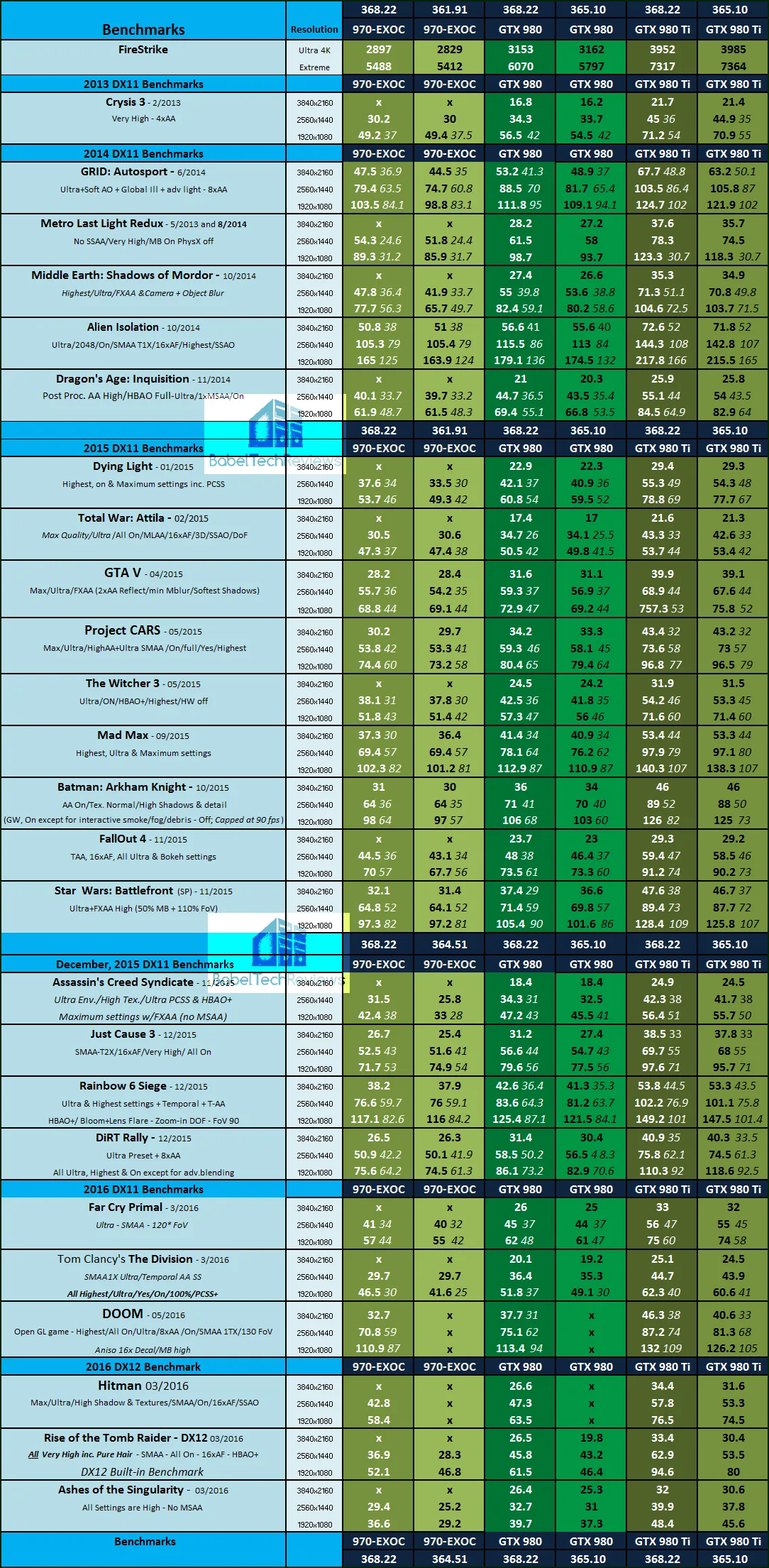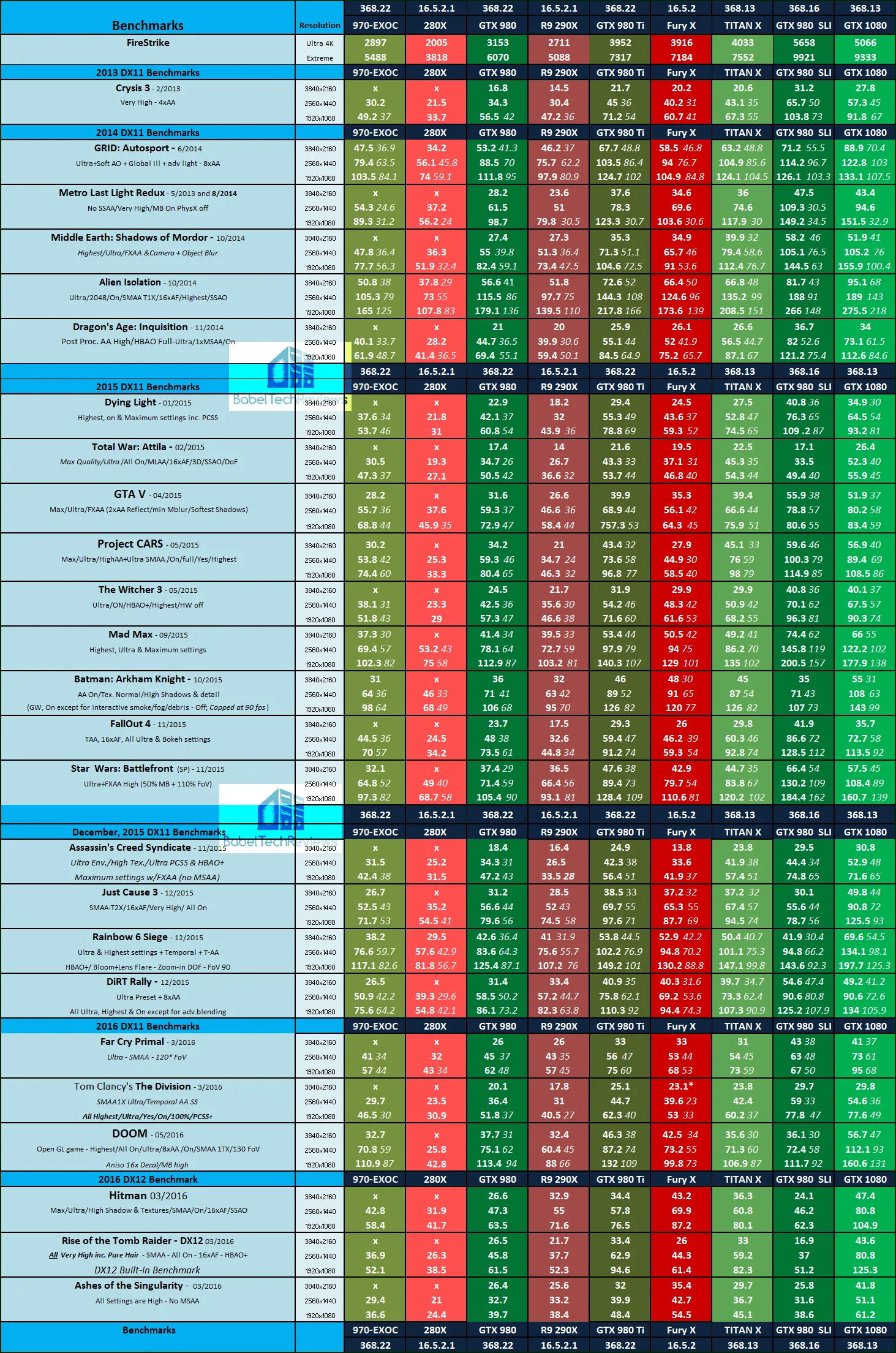Today’s driver performance analysis charts the performance of 25 games using the GTX 980 Ti, the GTX 980, and the GTX 970 with the very latest GeForce WHQL driver 368.22, and we are also focusing on the competing Fury X, 290X, and 280X with AMD’s Crimson Software version 16.5.x.

We are also benching with these new drivers from both AMD and Nvidia featuring our newest 2016 games including Far Cry Primal, Tom’s Clancy’s The Division, as well as Ashes of the Singularity, Hitman, and Rise of the Tomb Raider using DX12. We will compare the performance of 25 modern games, including the very latest, at 1920×1080, 2560×1440, and at 3840×2160 resolutions for our recently revamped benching suite.
BTR’s The Big Picture, once reserved for video card reviews is now included in every driver performance analysis. We want to document the performance changes of the older GeForce WHQLs driver since we last tested them on Windows 10.
It is clear that Nvidia is focusing on VR and especially on the very latest games with their newest WHQL driver GeForce 368.22. AMD also appears to be focused on these same games with Crimson Software 16.5x, so this will be an interesting evaluation.
Our testing platform is Windows 10 Home 64-bit, using an Intel Core i7-4790K at 4.00GHz which turbos to 4.4GHz for all cores as set in the motherboard’s BIOS, an ASUS Z97E motherboard, and 16GB of Kingston “Beast” HyperX DDR3 at 2133MHz. The settings and hardware are identical except for the drivers being tested.
At R9 280X or at GTX 970 performance level and above, we test at higher settings and resolutions generally than we test midrange and lower-end cards. All of our games are now tested at three resolutions when they make sense (above 25 fps average), and we use DX11 or DX12 when available with a very strong emphasis on the latest demanding 2015-2016 PC games.
Let’s get right to the test configuration, to the driver release notes, and then to the results.
Test Configuration – Hardware
- Intel Core i7-4790K (reference 4.0GHz, HyperThreading and Turbo boost is on to 4.4GHz; DX11 CPU graphics), supplied by Intel.
- ASUS Z97-E motherboard (Intel Z97 chipset, latest BIOS, PCIe 3.0 specification, CrossFire/SLI 8x+8x)
- Kingston 16 GB HyperX Beast DDR3 RAM (2×8 GB, dual-channel at 2133MHz, supplied by Kingston)
- GeForce GTX 980 Ti, 6GB reference clocks, supplied by Nvidia
- GeForce GTX 980, 4GB, reference clocks, supplied by Nvidia
- GALAX GTX 970 EXOC, GALAX’ factory overclock, supplied by GALAX
- PowerColor R9 Fury X 4GB, stock clocks.
- VisionTek R9 290X 4GB at stock Uber clocks but with the fan allowed to spin up to 100% to prevent throttling.
- Two 2TB Toshiba 7200 rpm HDDs
- EVGA 1000G 1000W power supply unit
- Cooler Master 2.0 Seidon, supplied by Cooler Master
- Onboard Realtek Audio
- Genius SP-D150 speakers, supplied by Genius
- Thermaltake Overseer RX-I full tower case, supplied by Thermaltake
- ASUS 12X Blu-ray writer
- Monoprice Crystal Pro 4K
Test Configuration – Software
- Nvidia’s GeForce latest 368.22 WHQL drivers were used to benchmark the GTX 980 Ti, the GTX 980 and the GALAX GeForce 970 EXOC. The GTX 980 and GTX 980 Ti are compared the with older drivers, GeForce 365.10, and the GTX 970 EXOC was previously benchmarked with GeForce 364.51. High Quality, prefer maximum performance, single display. Nvidia divers used in the Big Picture are noted on the chart.
- The AMD Crimson Software 16.5.2.2 beta drivers were used for benching the 280X and for the 290X, while 16.5.2 was used for the Fury X. All drivers are noted on the chart.
- VSync is off in the control panel.
- AA enabled as noted in games; all in-game settings are specified with 16xAF always applied
- All results show average frame rates including minimum frame rates shown in italics on the chart next to the averages in smaller font.
- Highest quality sound (stereo) used in all games.
- Windows 10 64-bit Home edition, all DX11 titles were run under DX11 render paths. Our only DX12 title is run under the DX12 render path. Latest DirectX
- All games are patched to their latest versions at time of publication.
- EVGA’s Precision XOC, latest version for Nvidia cards.
The 25 PC Game benchmark suite & 1 synthetic test
- Synthetic
- Firestrike – Basic & Extreme
-
DX11* Games
- Crysis 3
- Metro: Last Light Redux (2014)
- GRID: Autosport
- Middle Earth: Shadows of Mordor
- Alien Isolation
- Dragon’s Age: Inquisition
- Dying Light
- Total War: Attila
- Grand Theft Auto V
- ProjectCARS
- the Witcher 3
- Batman: Arkham Origins
- Mad Max
- Fallout 4
- Star Wars Battlefront
- Assassin’s Creed Syndicate
- Just Cause 3
- Rainbow Six Siege
- DiRT Rally
- Far Cry Primal
- Tom Clancy’s The Division
- DX12 Games
- Ashes of the Singularity
- Hitman
- Rise of the Tomb Raider
Nvidia’s Control Panel settings:

Release Notes Highlights for GeForce 368.22
The release highlights for GeForce 368.22 can be found here together with a download link for Windows 10/8.1/7 64-bit. Below is a short list highlighting the fact that Nvidia’s WHQL driver release schedule is tied to the release of AAA games.
Prior to a new title launching, our driver team is working up until the last minute to ensure every performance tweak and bug fix possible makes it into the Game Ready driver. As a result, you can be sure you’ll have the best day-1 gaming experience for your favorite new titles.
Game Ready
Learn more about how to get the optimal experience for Overwatch, World of Tanks, and War Thunder
For the comprehensive release notes, you will need to download the .pdf
Benchmarks & Performance Analysis
GeForce 368.22 versus GeForce 365.10 & 361.91 (GTX 970)
Here are our results of 25 games and 1 synthetic compared between GeForce 368.22 WHQL drivers, and GeForce 365.10 WHQL drivers using the GTX 980 and the GTX 980 Ti; and compared with GeForce WHQL 361.91 for the GTX 970 EXOC. “X” means the benchmark was not run (particularly in the case of the GTX 970 where 4K is generally too demanding, under 25 fps average; or the game is too new for the older drivers), and “NA” means the benchmark could not be run or completed. And an Asterisk (*) means that there are some real issues with the visuals.
All results except for Firestrike are expressed in average fps (in Bold) and also generally minimum fps (where they make sense, in smaller italics next to the averages).
 Each set of drivers are compared against the other in the adjoining results column in white (newest driver) versus black (older drivers).
Each set of drivers are compared against the other in the adjoining results column in white (newest driver) versus black (older drivers).
We can see great performance gains for our test cards with the newest drivers with many games. This driver is very stable and in our opinion, a very worthwhile upgrade. We saw only a few cases with slight decreases that did not affect these few games’ playability. We are quite impressed with GeForce 368.22!
Finally, let’s check out our bigger picture next.
The Big Picture
The Big Picture, once reserved solely for our video card reviews, has been recently expanded to feature all of our competing top video cards on recent drivers. We are benching the GTX 980 Ti and the GTX 980 versus the Fury X, the GTX 970 OC versus the R9 290X and even the 280X; and for added information, TITAN X, the new GTX 1080, and GTX 980 SLI results. Driver revisions for each card are noted on the chart and the AMD cards are benched on their latest series of Crimson Software drivers.
“X” means the benchmark was not run, while “NA” means the benchmark could not be run or completed. And an Asterisk (*) means that there are some real issues with the visuals. All results except for Firestrike are expressed in average fps (in Bold) and also generally minimum fps (where they make sense, in smaller italics next to the average results).
Let’s head to our conclusion.
Conclusion:
We would recommend upgrading to the latest GeForce 368.22 drivers as they have brought some solid improvements to most of our tested games. There are generally incremental advantages over older drivers, but with also some rather large performance increases. We always recommend using Nvidia’s latest WHQL driver for Windows 10.
 GeForce WHQL 368.22 is generally the best driver to use for the latest really fun games that we are playing, including Rise of the Tomb Raider, Far Cry Primal, Hitman, Tom’s Clancy’s The Division & DOOM.
GeForce WHQL 368.22 is generally the best driver to use for the latest really fun games that we are playing, including Rise of the Tomb Raider, Far Cry Primal, Hitman, Tom’s Clancy’s The Division & DOOM.
It appears that both Nvidia and AMD intend to release new drivers with each new major PC game release, and we are looking forward to our next new hardware review before next week.
Happy gaming!
